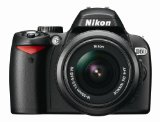Difference Between Canon XTi and Nikon D60

The camera war for perfection, compatibility and state of the art SLR technology has helped evolve few notable varieties in the market. The Cannon XTi and Nikon D60 are two products competing in the market with their fineness.
Nikon tried to bypass Cannon, who is the market leader, with its launch of the EOS 300D, or digital rebel model. The Nikon D60, a third avatar of Nikon, is a compact SLR with user-friendly features introduced as the entry-level model in 2006. The Nikon D60 drew a lot of inspiration from the D40, which was a successful model from Nikon.
The D40 had a good design, pricing strategy and excellent output. All these made the D40 a star performer, and caused a turnaround in the market. The D60 can be defined as a replacement model for the D40. The makers of the camera retained the censors and external design of the camera for the D60, largely from the D40. There are other features, such as the Expeed processing concept, eye sensor (controls the display screen), active day lighting and tweaked interface, which were different from its earlier version. This new version gave a stabilized lens kit, making it a better version.
Expeed used in the Nikon D60 helps to maximize the quality of the image, and the speed of image processing. These design features help to optimize the adjustments made to the image without any external help, such as by using a computer. The components like active d-lighting helps to compensate for strong shadows. The built in flash helps in the auto correction of faux eyeshade. Apart from these interesting features, the D60 model allows you to create sequences of images using stop-motion technology for animation. The effects available in the camera allow you to use the optical filters to create shades of colors and highlights.
The Canon EOS 400D is widely known as the Digital Rebel XTi through North America, and is a digital camera with single-lens reflex, introduced as a mid range product by Canon in 2006. The Canon XTi was launched to succeed the Canon 350D. The XTi upgraded with ten point one-megapixel cmos sensor, a big shooting buffer to facilitate continuous shooting, an image sensor integrated to vibrate and clean the system, nine point auto focus, improved handhold, two point five inch LCD, and a large viewing screen. This upgraded version of the XTi is a digital SLR that provides a state of the art combination of user-friendly features, performance and value for money. The Rebel XTi is small, however it is loaded with features like a fast frame rate. This Cannon looks big in spite of its frame size. This camera offers professional clicks.
Summary:
1. The XTi upgraded with ten point one-megapixel cmos sensor, a big shooting buffer, an image sensor, auto focus, improved handhold, two point five inch LCD, and a large viewing screen. It offers state of the art image processing.
2. In spite of the fact that Nikon is the best entry level camera, it has a slow autofocus system, making the image clicking process a difficult one.
3. The Canon offers value for money, while the Nikon is a good bet as an entry level model.
- Difference Between Schizophrenia and Psychosis - March 7, 2024
- Difference Between African and Asian Elephants - March 7, 2024
- Difference Between Sunscreen and Sunblock - February 15, 2024
